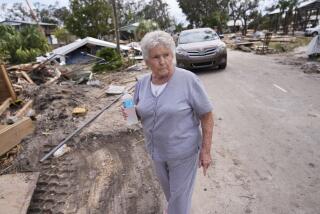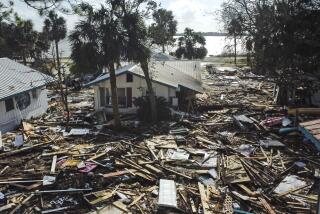Gulf communities underwater from Lee
- Share via
Reporting from Atlanta — Faced with an onslaught from Tropical Storm-turned-Tropical Depression Lee, scattered Gulf Coast communities from Alabama to Louisiana were underwater, even as New Orleans’ upgraded pumps and levees continued to hold.
Cities and towns along the Eastern Seaboard, meanwhile, including some hammered recently by Hurricane Irene, braced for their turn as the system moves north. Having done its initial damage as a tropical storm, Lee lost steam Sunday night and was downgraded to a depression.
The storm’s center chugged between Lafayette and Baton Rouge in Louisiana on Sunday afternoon, headed north-northeast at about 8 mph, according to the National Weather Service. New Orleans Mayor Mitch Landrieu said Lee’s wind and rain would continue to plague his city through Monday afternoon.
But Landrieu reported that the city was in good shape Sunday, with streets generally clear and damage to homes minimal. He again warned, however, that the storm — which he described as “very stubborn, persistent, slow-moving, unpredictable” — still packed the risk of fresh trouble.
“Just because it’s been slow it does not mean it’s over,” he said at a Sunday afternoon news conference.
The National Hurricane Center seemed to agree, warning of extremely heavy rainfall over much of the Southeast in the next few days. The rain was “expected to cause extensive flooding and flash flooding,” the center said on its website.
Just miles from New Orleans, meanwhile, there was misery. Flooding was reported in a number of outlying parishes. Mississippi emergency management officials reported flooded roads and damaged homes across that state’s three-county coastal region. And residents there and in Alabama reported spinoff tornadoes, according to the Associated Press.
Some of the most dramatic trouble came in southern Jefferson Parish, where about half of a cluster of fishing and oil and gas communities — Jean Lafitte, Crown Point and Barataria — were underwater, with 6 to 7 feet of water in some areas, said Timothy Kerner, mayor of Jean Lafitte.
Winds from Lee had pushed water from the Gulf of Mexico to inland waterways, including Bayou Barataria, which Kerner said was about 5 feet higher than normal Sunday.
“Oh my God, man,” he said. “We’re actually building little rock levees, sandbagging — so many doggone things we’re trying to do.”
The communities, which are home to about 8,000 people, lie just outside of metro New Orleans’ flood-control system, which received a multibillion-dollar upgrade after its failure during Hurricane Katrina in 2005.
Kerner said a massive pump and floodwall installed north of his communities had exacerbated flooding in his area Sunday. He said federal authorities had not heeded locals’ requests to protect his area with levees.
“They haven’t spent a dime on us,” he said. “It’s a shame when the country leaves you out of a system and then says it can’t protect you.”
AccuWeather meteorologists predicted the storm would degrade to a low pressure system around Tuesday, when it would bring heavy rain to Washington, D.C., Lynchburg, Va., and Winston-Salem, N.C.
Flash flooding is a particular concern for parts of the Appalachian region.
Meanwhile, the National Hurricane Center announced that Katia, a storm churning in the Atlantic Ocean, had strengthened again to hurricane status, this time at Category 2, with maximum sustained winds of almost 100 mph.
No coastal watches or warnings have been issued, but the hurricane center said the storm’s fate remained clouded by “a lot of uncertainty.”
More to Read
Sign up for Essential California
The most important California stories and recommendations in your inbox every morning.
You may occasionally receive promotional content from the Los Angeles Times.













